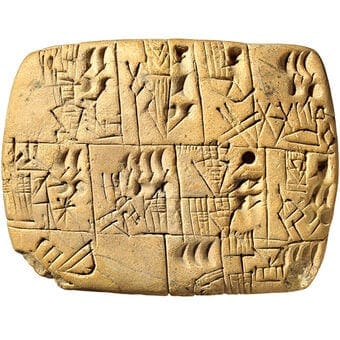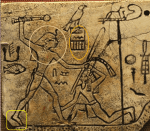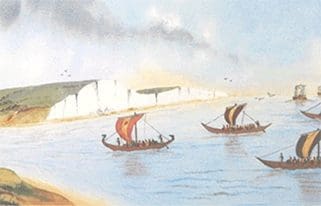
This article should inform your teaching of the Ancient Civilizations topic
Imagine a world without writing-without any writing at all: no literature; no news stories; no history even. No tax returns! Well that was the world about 5000 year ago. And then with the advent of city-based civilizations came writing in many different forms. ‘Of mankind’s advances’ , wrote Neil McGregor when he was Director of the British Museum, ‘the development of writing is surely the giant; it could be argued that it has had more impact than any other single invention’.
Among the first was a clay tablet from Mesopotomia inscribed with pictographs showing containers of beer. Who deserved which amounts was now being recorded and has lasted thousands of years. Story writing then followed about 4,000 BC. Writing seems to have emerged independently in Mesopotamia, China and Central America. Mesopotamia was probably the first to develop it, but that may simply be because more evidence in the form of clay tablets has survived.
So what do our KS2 pupils need to know about these ancient writing systems
- The first form of written communication called cuneiform was invented by the Sumerians of southern Mesopotamia as long ago as 3500 BC. Pictures were scratched onto clay tablets. Having a writing system was essential to administer cities. The reed was mightier than the sword!
- The Sumerians were responsible for the first ever story to be written down, a story about a flood similar to Noah’s ark story. Other types of writing included lists of laws and punishments as well as accounts, records and even hymns
- Writing developed to record who owned what, the debt people had and who had paid or not paid their taxes. For example, the first clay tablets were attached to bags of grain to show who owned them
- The people of the Indus Valley invented what may have been a writing system based on almost 400 different pictographs in around 3500 BC. Sadly, no one has been able to decipher them.
- Ancient Egyptians used hieroglyphs for recording information about government and religion but they used a different system for everyday use. The word hieroglyph means scared carving as the Ancient Egyptians believed they had been invented by the gods. There are no vowels in hieroglyphics. You can work out whether to read the lines left to right or right to left by looking at the direction birds etc are facing.
- It was not until the discovery of the Rosetta Stone in 1799 that scholars were able to decipher ancient Egyptian hieroglyphs. They were able to use their knowledge of ancient Greek to translate the symbols.
- The ancient Chinese invented a pictographic writing system during the Shang Dynasty (1600 – 1046 BC). We can find evidence from Oracle bones and even bamboo, written on with soot, water and glue.
- It is important that pupils make links between the writing systems of the different civilizations they study so that when they look at cave paintings in the context of the Stone Age topic they can relate this to hieroglyphics. Similarly, when they study the ancient Greek civilizations such as the Minoans of ancient Crete they are able to think of the types of writing system used at that time.
- When studying the Greeks they should realise that they wrote extensively so we can use their books to work out what their society was like
- Link too to the Romans as the Roman alphabet forms the basis of the alphabet used by many modern languages. Although the letters J, U came after the Roman period we study, the other 23 letters were the same as the upper case letters used today. The Roman Latin language was widely used for centuries and is its influence is widely found in our language today
These ideas draw heavily on those Dr Matthew Laban is a headteacher and historian who is a Fellow of the Royal Historical Society. He serves on The Historical Association’s Primary Committee and wrote an article in the Autumn 2020 edition of Primary History








